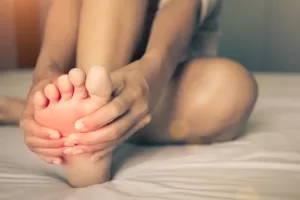Plantar Fasciitis- symptoms, causes & treatment
What is the Plantar Fascia?
- The plantar fascia is a thick fibrous layer of tissue that supports the arch of the foot.
- It starts at the heel bone and stretches forward under the arch, fanning out and attaching to the underside of each of the toes. It acts as a support structure and a “shock absorber”.
What is Plantar Fasciitis?
- Plantar fasciitis is a very common cause of heel and foot pain.
- Over time, the plantar fascia can become injured, with the fibres undergoing “wear and tear”- this is known as plantar fasciitis.
- Plantar fasciitis is thought to be caused by microscopic tears occurring in the fascia- not inflammation, as was once assumed.
What are the symptoms of Plantar Fasciitis?
- The most typical symptoms of Plantar Fasciitis include heel pain, and sometimes pain throughout the sole of the foot.
- It’s often worse in the morning or after rest, and improves with movement, though it may be aggravated by longer periods of weight-bearing.
- The fascia is thinnest near the heel, so it’s often the first place to be injured.
- It may be tender to press firmly under the heelbone, and there may discomfort in the sole of the foot if you pull the big toe fully upwards.
What causes plantar fasciitis?
It is thought that plantar fasciitis is caused by activities that place an increased load on the fascia- such as prolonged standing or running. Certain factors seem to increase the risk of plantar fasciitis:
Anatomy
- Flat feet (but high arched feet can be a risk too)
- Obesity
- Short achilles tendons
Biomechanical problems
- If the foot tends to roll inwards (overpronate) when walking or standing
- Weakness of the small “intrinsic” muscles of the foot
- Reduced ability to flex the foot upwards at the ankle (dorsiflexion)
Other factors
- Sports that involve lots of running and/or jumping
- Walking barefoot a lot
- Walking on a hard surface a lot of the time, or standing for prolonged periods e.g at work- particularly if unfit or overweight
- Poor or worn-out footwear
- General poor fitness and deconditioning
- Pregnancy (the weight gain and hormonal changes lead to increased risk of injury)
How is plantar fasciitis diagnosed?
- Diagnosis is usually based on the typical symptoms of Plantar Fasciitis, such as a history of heel and foot pain, as noted above.
- There is usually tenderness/pain when the doctor presses under the heel or along the plantar fascia. Pain may also be triggered if the toes are pulled upwards.
- If a person also has flat feet, tight achilles tendons, or obviously overpronates when walking, it may further support the diagnosis.
- Sometimes the doctor may request imaging. Xrays are not usually required but are sometimes done if the doctor wants to rule out a stress fracture or some other bone injury. Ultrasound is also not always required (if the diagnosis is obvious)- however, if performed it may show thickening of the plantar fascia. Sometimes a calcaneal spur (or heel spur) may be picked up on X-ray or ultrasound- heel spurs are bony protrusions from the heel-bone. Some people with plantar fasciitis may have associated heel spurs (though the spurs are generally not the cause of the foot pain).
- Less often blood tests or an MRI may be requested, if the diagnosis is in doubt.
What is the best treatment for plantar fasciitis?
There are a few options which may offer some benefit, though a person may need to try more than one of these to find the approach that is best for them. For most of these options, there is not yet enough research to show how well they work.

General advice includes
- losing weight if overweight/obese
- resting the feet
- ice and painkillers may help with symptom relief
-
podiatry assessment and improved foot support may help correct the problem.
- variation of training regimes (e.g addition of cycling and swimming, and a reduction in running and higher impact activities)
Stretching exercises-
- Physiotherapists may advise stretching exercises and deep massage. It’s not clear how effective this approach is- some studies have shown it may help, but it’s by no means clear!
- Ultrasound, laser or injection are also sometimes advised- again, there is a lack of evidence as to how effective these types of treatment are.
Orthotics and splints-
- Some studies have suggested that orthotics for heel and arch support may benefit certain people, though it’s not clear if they make a significant difference in overall recovery. It’s usually advised that they should be worn in both feet, even if only one foot is symptomatic.
- Night splints can be used to keep the ankle flexed upwards (dorsiflexed) with the toes also stretched upwards (extended)- this may help to stretch the plantar fascia and may assist healing.
Steroid Injections
Studies have shown some short-term relief, but the benefit in the longer term is not certain. Ultrasound may be used to guide insertion of the needle. There is a small risk that steroid injection will cause rupture (breakage) of the plantar fascia. It’s not advisable to have more than 2 or 3 steroid injections in a 6 month period.
Extracorporeal shock-wave therapy
Some experts believe this may offer some benefit. It is safe, but like many of the other options, the research is not absolutely clear in terms of the benefits.
Autologous blood injection
This may be offered by certain therapists, but there is a lack of good evidence for it, and it’s likely that steroid injections are more effective.
Surgery
This is very rarely recommended, and benefits are very unclear. There is a risk of infection and nerve damage with any invasive surgery.
Does Plantar Fasciitis get better?
Whilst symptoms of Plantar Fasciitis may persist for years, for most people it tends to get better naturally over 3-6 months, though people with Plantar Fasciitis in both feet tend to have a slower recovery.
For more information about Plantar Fasciitis, heel pain or foot pain, speak to your GP, physio or podiatrist.
Getting a Mental Health Care Plan in Australia: Your Guide
Getting a Mental Health Care Plan in Australia: Your Guide Mental health matters—and if you’re feeling overwhelmed, anxious, or down, a mental health care plan can help. But what is it, and how do [...]
UTI Symptoms and Treatment: What You Need to Know
UTI Symptoms and Treatment: What You Need to Know Urinary Tract Infections (UTIs) are common, uncomfortable, and often disruptive. But what exactly are the signs to watch for, and how can you get relief [...]
Free Mental Health Care Plan Online | Bulk-Billed by Qoctor
Free Mental Health Care Plan Online | Bulk-Billed by Qoctor Discover how to get a free, bulk-billed Mental Health Care Plan (MHCP) in Australia through Qoctor's telehealth service. Accessing [...]





